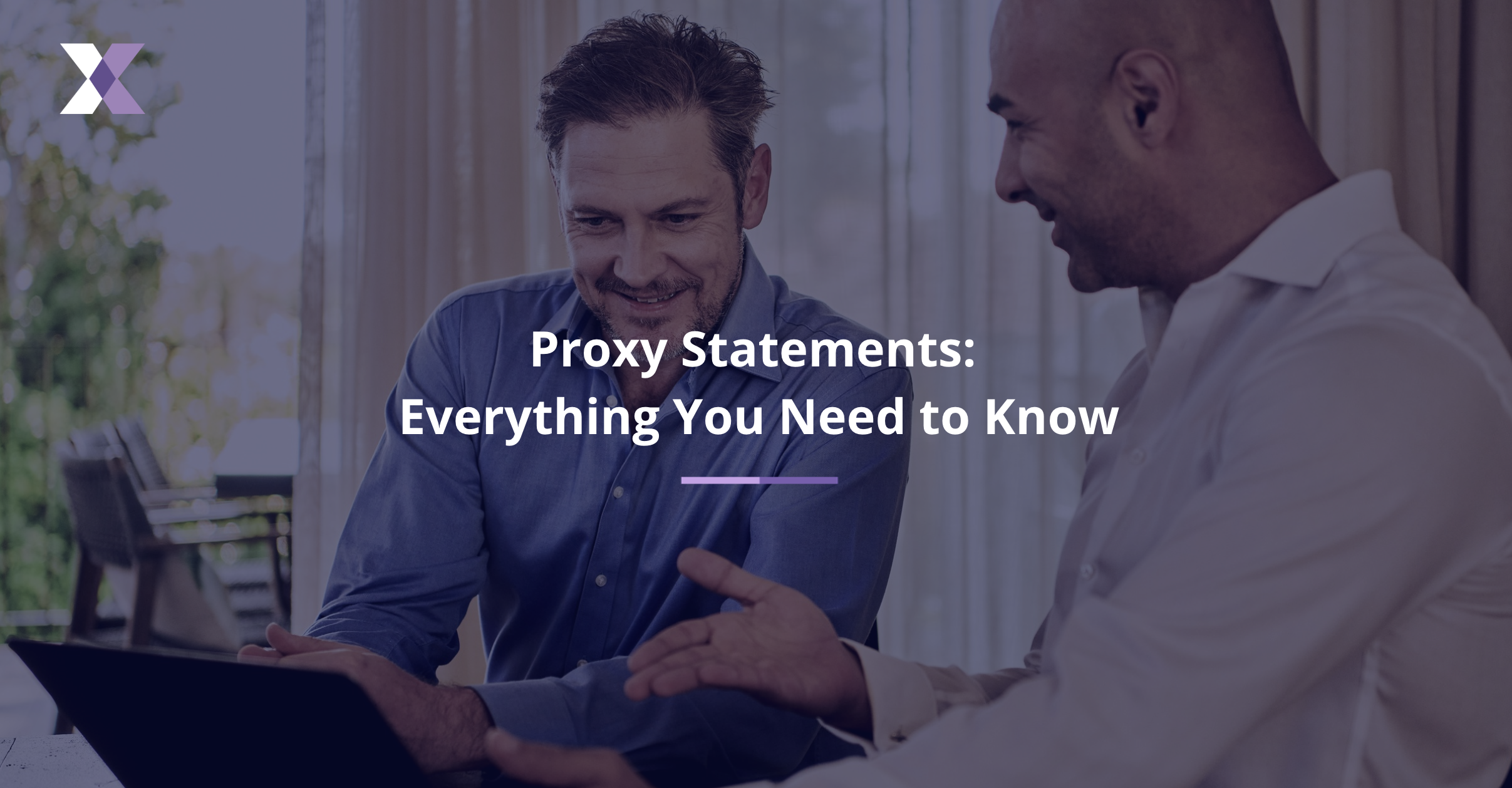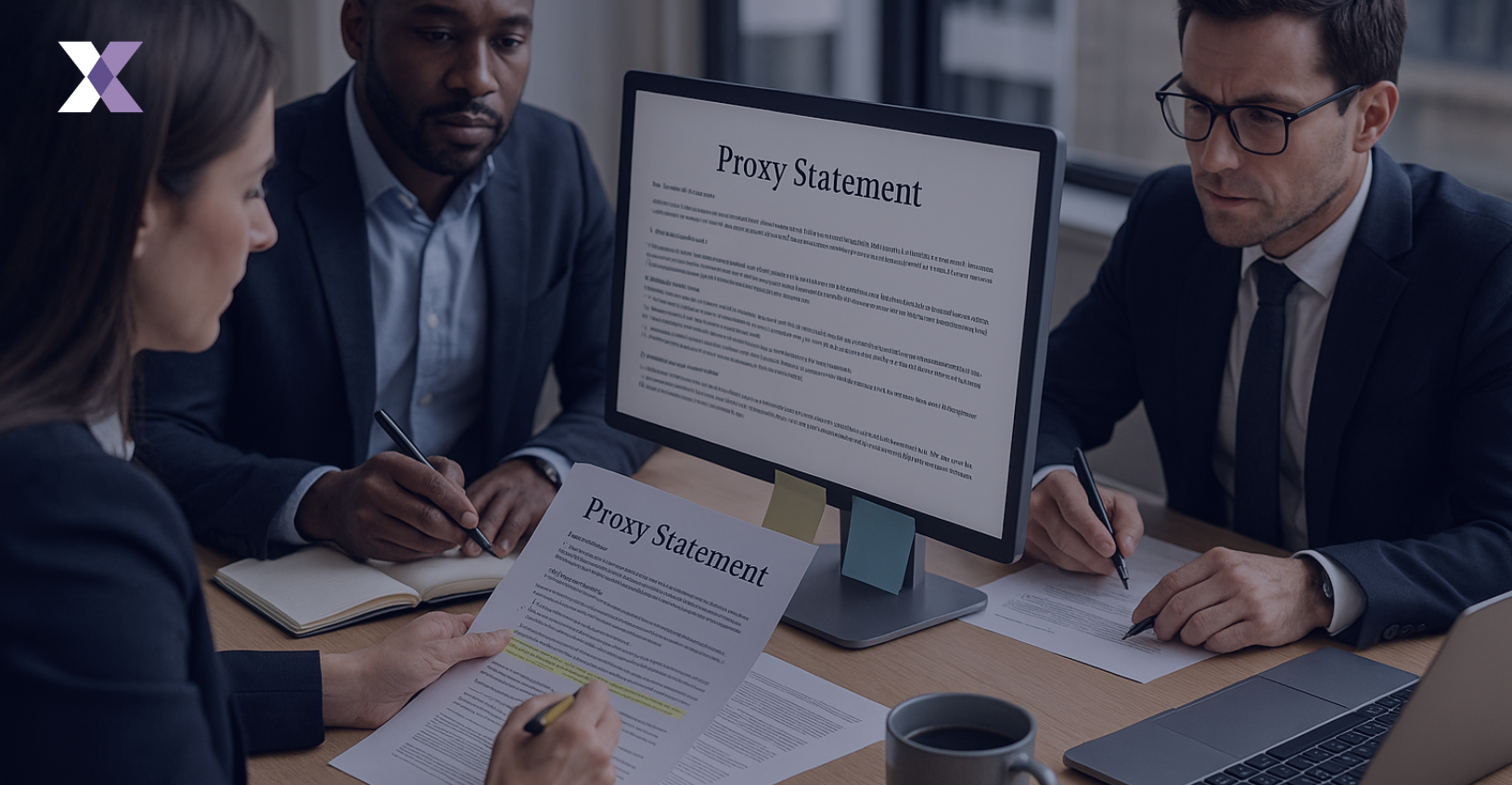Views
Proxy Statements: Everything You Need to Know

Every publicly traded company in the U.S. needs a proxy statement. It’s an important document and tool for managing communication between a company and its shareholders. That’s because it serves as a bridge, helping investors make informed decisions about critical aspects of a company’s operations, leadership, and future direction.
As your business and operations evolve, technology can help you keep your proxy statement accurate and effective alongside other important communications with shareholders. This article explores the basics of proxy statements and how Proxymity’s technology for shareholder engagement can help maximize their value.
Proxy statements – more than a simple agenda
A proxy statement is a document publicly listed companies send shareholders ahead of a shareholder meeting or an AGM. It outlines key items up for vote, for example director elections, executive pay, and major corporate decisions.
In North America, proxy statements must be filed with regulators. In the U.S., for example, the SEC requires companies to comply with Schedule 14A by submitting Form DEF 14A.
The purpose of a proxy statement – Inform and include
While proxy statements are required by the SEC, their core purpose is to help shareholders make informed voting decisions, even if they cannot attend meetings. By transferring voting rights to a proxy, shareholders ensure their voice is heard.
All parties within the investment ecosystem benefit from well-written proxy statements:
• Issuers build trust and transparency
• Intermediaries ensure compliance and smooth voting
• Investors make better governance decisions
Components of a proxy statement – It’s all about the details
If you are responsible for producing and managing your company’s proxy statement, there are critical best practices for drafting a proxy statement you should take into account. For example, a typical proxy statement includes:
• Shareholder meeting details (e.g., date, time, location)
• Proposals on which shareholders will vote
• Information about director nominees
• Executive compensation disclosures
• Corporate governance policies
• Audit committee report
• Shareholder proposals (if any)
Here, you can reference the SEC’s EDGAR database for examples of proxy statements filed by U.S. companies.
Why aren’t you realizing the full value of proxy statements?

Even with these effective approaches, several factors can diminish the effectiveness of proxy statements. For example:
• Distribution issues: Traditional methods of distributing proxy materials can be slow or even go unnoticed, reducing the time shareholders have to review and make informed decisions.
• Misinterpretation: Complex language or poorly presented information can lead to misunderstandings about key issues.
• Lack of real-time updates: Once distributed, traditional proxy statements can’t be easily updated to reflect new information or changes.
• Limited engagement: Traditional formats may not facilitate easy two-way communication between companies and shareholders.
• Problems processing votes: Shareholders may misunderstand voting procedures in the document; manually processing votes can lead to delays and potential errors as well.
These challenges can hurt shareholder engagement and the quality of corporate governance.
Connected solutions for proxy statements and voting
New technologies address the challenges associated with traditional proxy statements and issues with voting processes. These solutions aim to make proxy statements more useful, accessible, and impactful.
Proxymity offers a suite of products designed to enhance the effectiveness of proxy statements and improve corporate governance practices. Our technology addresses many of the gaps in obtaining full value from proxy statements described above.
Improving distribution and processing
For example, Proxymity Vote Connect North America is a centralized platform that improves how proxy materials, including proxy statements, are distributed and processed. Key benefits include:
• Real-time distribution: Proxy materials are sourced directly from the issuers or their agent’s publication on the SEC EDGAR website and shared with investors or connected intermediaries instantly, eliminating delays in the custody chain.
• Greater accuracy: Direct sourcing of materials reduces the risk of misinterpretation or distortion of information as it passes through intermediaries.
• More transparency: The platform provides real-time tracking of the entire proxy voting process, from distribution to vote confirmation.
Visibility into shareholders and votes

Technology can also improve transparency and engagement between participants in the custody chain. Proxymity’s Insights solutions address key gaps in these areas:
• Shareholder Insights provides issuers with a clear view of their shareholder base, helping them understand and engage with investors
• Vote Insights offers real-time information on how shareholders vote, allowing issuers to better understand investor sentiment and respond in a proactive way.
All these methods address key challenges of connectivity, timeliness, and transparency. They can ensure proxy statements fulfill their intended purpose: improving dialogue and fostering better decisions among issuers, intermediaries, and shareholders.
Frequently asked questions (FAQs) about proxy statements
Now that we’ve discussed the basics of proxy statements and the value of centralized solutions like Proxymity, let’s answer a few frequently asked questions.
What are the types of proxy statements?
It’s important to know the difference between a definitive proxy statement and a preliminary proxy statement, as well as an annual report. You also should know when each type of proxy statement needs to be filed.
What is a definitive proxy statement?
This is the finalized version filed with the SEC, typically at least 40 calendar days before the shareholder meeting. It contains key voting information for investors during shareholder meetings.
What is a preliminary proxy statement?
Filed ahead of certain special meetings (e.g. contested board elections, mergers, or major corporate actions). It allows the SEC to review and comment before the final statement is shared. Must be filed at least 10 days before the definitive version.
What is a proxy statement vs an annual report?
Proxy statements are made for shareholders to make governance decisions and consist of all the resolutions to be voted on. Annual reports provide a broader view of company performance and outlook, intended for all stakeholders.
How to create a proxy statement?
A clear, well-structured proxy statement supports better shareholder communication. Here’s how to create one:
• Start strong: Include a brief executive summary or meeting notice with key voting items like director elections and proposals.
• Detail board and executive info: Share bios, qualifications, and explain how executive compensation aligns with performance.
• Add key disclosures: Highlight ESG and DEI topics relevant to your business and industry.
• Show engagement: Explain how shareholder feedback is gathered and used in decision-making.
• Clarify voting instructions: Outline how and when to vote, covering all options (online, mail, in-person).
How to read a proxy statement?

Here are some suggestions regarding how to read a company’s proxy statement:
• Start with the notice of annual meeting, which outlines the key issues to be voted on.
• Review the voting procedures and deadlines.
• Examine the board of directors’ nominees and their qualifications.
• Analyze the executive compensation section, including performance metrics and pay ratios.
• Study any shareholder proposals and the board’s recommendations.
• Review the company’s financial performance and future outlook.
How to find a proxy statement?
U.S. companies’ definitive proxy statements can be found through several methods:
• The SEC’s EDGAR database: Search for a company’s filings using their ticker symbol or company name.
• Company websites: Search for an “Investor Relations” or similar section.
• Financial / proxy statement news websites: Many provide links to companies’ proxy statement SEC filings.
• Brokerage accounts: Some brokers provide shareholders with direct access to proxy materials for their stocks.
How to cite a proxy statement?
When citing a proxy statement using APA style, include the following information:
• Company name
• Year of the proxy statement
• “Proxy Statement”
• Date of filing
• SEC web link or accession number
Consider this proxy statement example from Apple Inc.—you could cite this proxy statement as follows:
Apple Inc. (2021). Proxy Statement. Filed January 5, 2021. https://www.sec.gov/Archives/edgar/data/320193/000119312521001987/d767770ddef14a.htm.
The future of proxy statements and voting

Proxy statements remain a cornerstone of corporate governance, providing crucial information to shareholders and facilitating their participation in key company decisions. With Proxymity, your proxy process can also evolve to become more efficient, transparent, and effective.
For more information about Proxymity and its investor communication technologies, contact us directly.
